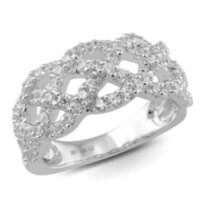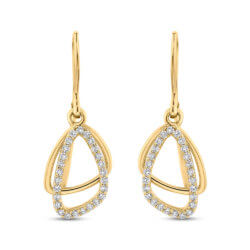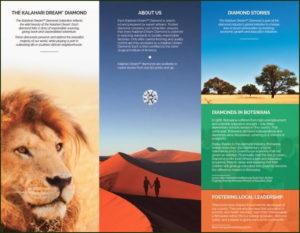Understanding The Future Of Diamonds
While the diamond sector must continue to meet the needs of Baby Boomer and Gen X consumers, it also must commit to understanding Millennial and Gen Z consumers, and adapt its marketing approaches to incorporate their needs and priorities.
 De Beers advocates this message aggressively in it Diamond Insights 2018 report, underscoring that the Millennial and Gen Z generations are bigger than the previous two, and they will soon have the highest spending power, and represent more than two-thirds of total diamond jewelry demand-value.
De Beers advocates this message aggressively in it Diamond Insights 2018 report, underscoring that the Millennial and Gen Z generations are bigger than the previous two, and they will soon have the highest spending power, and represent more than two-thirds of total diamond jewelry demand-value.
The report encourages jewelers to meet the needs of the younger generations for love and commitment on their own terms; tailor communications, messages and media to their behavior and preferences; and align brand purposes and social commitments with what is important to them.
Key Themes
Describing himself on the topside of Millennials age-wise, Robin Gandhi for Aneri Jewels and Laxmi Diamonds in New York, advocates jewelers promote diamonds beyond bridal; invest more in digital to provide an omni-channel experience that seamlessly mixes online and offline interaction; and share how their brand makes a difference in their community and the world. FYI, Millennials care about social causes, responsible consumerism, fair trade, and sustainability, as well as rejecting gender stereotyping and promoting greater diversity and inclusion, according to Diamond Insights 2018.
New York, advocates jewelers promote diamonds beyond bridal; invest more in digital to provide an omni-channel experience that seamlessly mixes online and offline interaction; and share how their brand makes a difference in their community and the world. FYI, Millennials care about social causes, responsible consumerism, fair trade, and sustainability, as well as rejecting gender stereotyping and promoting greater diversity and inclusion, according to Diamond Insights 2018.
Gandhi reports striking growth in non-bridal diamond jewelry sales the past two years, particularly for diamond earrings, pendants and bracelets. He sees the diamond business becoming a lot more fun. Diamond Insights calls out trends for individuality, creativity and informality in our society fueling demand for jewelry styles that are more casual and personal.
 Valerie Fletcher, Vice President of Design and Product Development for the NYC-based Original Designs Inc. (ODI) is a proponent of “everyday luxury”. Last year, ODI launched an empowering campaign with a “for me-from me” nod called, “I am a Woman”. Campaign collateral encourages women to celebrate their unique differences and journeys by gifting themselves with meaningful diamond-accented motifs like a solitaire-shaped pendant to remind that you have all the qualities of a diamond—beauty, strength and brilliance; cartwheel pendant symbolizing forward motion; and ladder designs using baguettes as the rungs, signifying upward mobility and success.
Valerie Fletcher, Vice President of Design and Product Development for the NYC-based Original Designs Inc. (ODI) is a proponent of “everyday luxury”. Last year, ODI launched an empowering campaign with a “for me-from me” nod called, “I am a Woman”. Campaign collateral encourages women to celebrate their unique differences and journeys by gifting themselves with meaningful diamond-accented motifs like a solitaire-shaped pendant to remind that you have all the qualities of a diamond—beauty, strength and brilliance; cartwheel pendant symbolizing forward motion; and ladder designs using baguettes as the rungs, signifying upward mobility and success.
Perhaps appealing to their desire for fun and originality, and out-of-the-box thinking, lab grown diamonds also are on Millennials’ radar. Raised on the advancements in technology and the choices afforded by them, Millennials are open minded to the product, says Cora-Lee Colaizzi, Director of Marketing and Catalogs and Senior Merchandiser for Quality Gold. The Fairfield, Ohio-based manufacturer launched last year its own lab-grown diamond jewelry brand, True Origin, which was among its bestsellers at the JCK Las Vegas Show. Colaizzi says lab-grown diamonds provide choice, not a replacement for mined diamonds.
Consumers, especially the younger generations, do not want to be told what they should want, says Neil Shah,  principal at Shah Luxury in New York City. “They want to personalize pieces and be involved in the design process in some way.” The trend for customization is fortified in their quest to mark their individuality.
principal at Shah Luxury in New York City. “They want to personalize pieces and be involved in the design process in some way.” The trend for customization is fortified in their quest to mark their individuality.
Out Reach
Gandhi encourages jewelers to reach out to Millennials where they are and in the ways the want to be connected with. Engage more with Millennials in the community. Create a focus group. Invite Millennials in to find out what they like and want. Hire more Millennials and include them in planning discussions. Have a smart presence on Instagram and YouTube. Remember, Millennials are experiential and they value convenience.
Samuel Sandberg, Chairman of the New York-based A. Jaffe, advocates jewelers be aggressive in marketing online. “Billboards don’t work. TV works to some extent. But now, it’s all digital.”
De Beers research suggests that brands and retailers who provide original and entertaining websites, apps and communications will lead the competition. Moreover, a seamless omni-channel experience is vital, as consumers want to be able to check inventory, schedule appointments, purchase and return, interchangeably on and off line. The report also finds environmental preservation and fair trade top issues that resonate with the younger generations.
 Leo Schachter Diamonds’ Kalahari Dream collection is a great example of a brand with a story of how diamonds do good that younger consumers can feel good about. Sales of Kalahari Dream diamonds help benefit community initiatives in Botswana, Namibia and South Africa where the stones are mined — like fund hospitals, schools, and clean drinking water. Social media has been an important channel for sharing humanitarian and environmental stories.
Leo Schachter Diamonds’ Kalahari Dream collection is a great example of a brand with a story of how diamonds do good that younger consumers can feel good about. Sales of Kalahari Dream diamonds help benefit community initiatives in Botswana, Namibia and South Africa where the stones are mined — like fund hospitals, schools, and clean drinking water. Social media has been an important channel for sharing humanitarian and environmental stories.
“With their focus on networks and instantaneous information sharing within an increasingly connected world, today’s consumers want businesses to demonstrate they understand what truly matters to them,” writes Bruce Cleaver, CEO De Beers Group, in Diamond Insights 2018. “To meet this expectation, we need to listen closely to consumers, bringing with us innovative and thought-provoking propositions that set us apart from the rest.”
Leave a Reply
You must be logged in to post a comment.